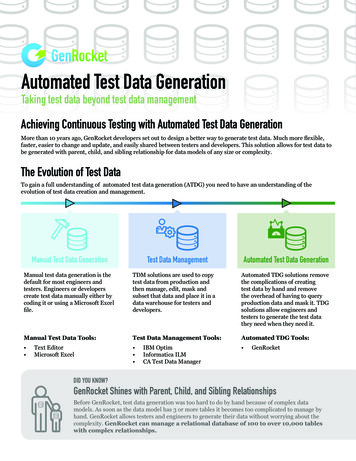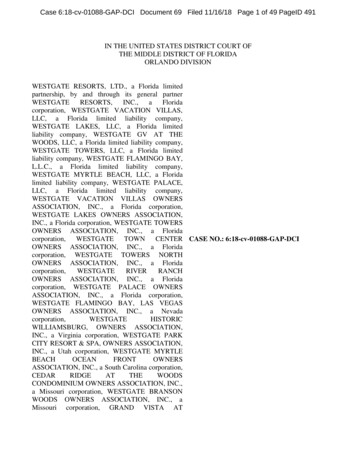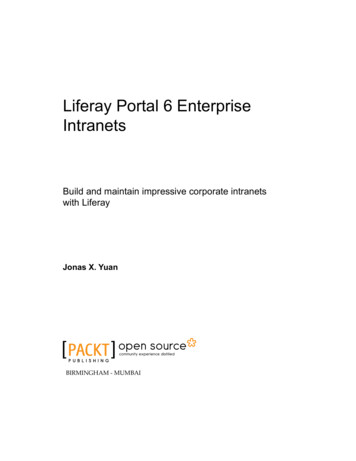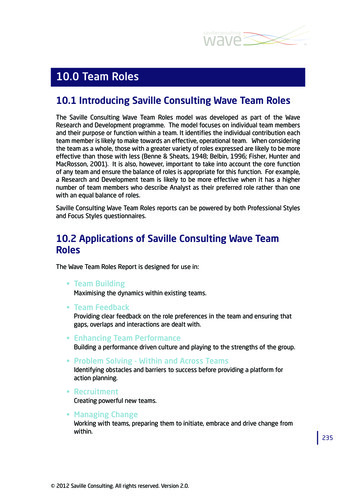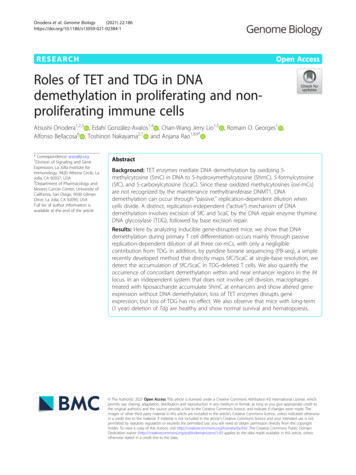
Transcription
Onodera et al. Genome Biology(2021) SEARCHOpen AccessRoles of TET and TDG in DNAdemethylation in proliferating and nonproliferating immune cellsAtsushi Onodera1,2,3 , Edahí González-Avalos1,4 , Chan-Wang Jerry Lio1,5 , Romain O. Georges1 ,Alfonso Bellacosa6 , Toshinori Nakayama2,7 and Anjana Rao1,8,9** Correspondence: arao@lji.org1Division of Signaling and GeneExpression, La Jolla Institute forImmunology, 9420 Athena Circle, LaJolla, CA 92037, USA8Department of Pharmacology andMoores Cancer Center, University ofCalifornia, San Diego, 9500 GilmanDrive, La Jolla, CA 92093, USAFull list of author information isavailable at the end of the articleAbstractBackground: TET enzymes mediate DNA demethylation by oxidizing 5methylcytosine (5mC) in DNA to 5-hydroxymethylcytosine (5hmC), 5-formylcytosine(5fC), and 5-carboxylcytosine (5caC). Since these oxidized methylcytosines (oxi-mCs)are not recognized by the maintenance methyltransferase DNMT1, DNAdemethylation can occur through “passive,” replication-dependent dilution whencells divide. A distinct, replication-independent (“active”) mechanism of DNAdemethylation involves excision of 5fC and 5caC by the DNA repair enzyme thymineDNA glycosylase (TDG), followed by base excision repair.Results: Here by analyzing inducible gene-disrupted mice, we show that DNAdemethylation during primary T cell differentiation occurs mainly through passivereplication-dependent dilution of all three oxi-mCs, with only a negligiblecontribution from TDG. In addition, by pyridine borane sequencing (PB-seq), a simplerecently developed method that directly maps 5fC/5caC at single-base resolution, wedetect the accumulation of 5fC/5caC in TDG-deleted T cells. We also quantify theoccurrence of concordant demethylation within and near enhancer regions in the Il4locus. In an independent system that does not involve cell division, macrophagestreated with liposaccharide accumulate 5hmC at enhancers and show altered geneexpression without DNA demethylation; loss of TET enzymes disrupts geneexpression, but loss of TDG has no effect. We also observe that mice with long-term(1 year) deletion of Tdg are healthy and show normal survival and hematopoiesis. The Author(s). 2021 Open Access This article is licensed under a Creative Commons Attribution 4.0 International License, whichpermits use, sharing, adaptation, distribution and reproduction in any medium or format, as long as you give appropriate credit tothe original author(s) and the source, provide a link to the Creative Commons licence, and indicate if changes were made. Theimages or other third party material in this article are included in the article's Creative Commons licence, unless indicated otherwisein a credit line to the material. If material is not included in the article's Creative Commons licence and your intended use is notpermitted by statutory regulation or exceeds the permitted use, you will need to obtain permission directly from the copyrightholder. To view a copy of this licence, visit http://creativecommons.org/licenses/by/4.0/. The Creative Commons Public DomainDedication waiver ) applies to the data made available in this article, unlessotherwise stated in a credit line to the data.
Onodera et al. Genome Biology(2021) 22:186Conclusions: We have quantified the relative contributions of TET and TDG to celldifferentiation and DNA demethylation at representative loci in proliferating T cells.We find that TET enzymes regulate T cell differentiation and DNA demethylationprimarily through passive dilution of oxi-mCs. In contrast, while we observe a lowlevel of active, replication-independent DNA demethylation mediated by TDG, thisprocess does not appear to be essential for immune cell activation or differentiation.BackgroundDNA cytosine methylation is the classic “epigenetic” mark. It is controlled by the functional interplay between two families of enzymes: DNA methyltransferases (DNMTs)and TET methylcytosine dioxygenases, which control DNA methylation and demethylation, respectively [1–4]. DNMTs transfer a methyl group from S-adenosylmethionine(SAM) to the 5 position of cytosine to generate 5-methylcytosine (5mC), the bulk ofwhich is present in the CpG (CG) sequence context [1–5], whereas TET proteins areFe(II) and 2-oxoglutarate-dependent dioxygenases that oxidize the methyl group of 5methylcytosine (5mC) to 5-hydroxymethylcytosine (5hmC), 5-formylcytosine (5fC), and5-carboxylcytosine (5caC) in DNA [6–9]. TET enzymes are now known to mediate essentially all of the dynamic DNA demethylation that occurs in mammalian genomesduring embryogenesis, cell lineage specification in developing embryos and organs, andcell differentiation in response to environmental cues [3, 10, 11].There are at least two mechanisms by which TET proteins can mediate DNAdemethylation. The first, known as “passive” or replication-dependent DNA demethylation, occurs during DNA replication, when 5mC complementary to the G in CGsequences in the template strand is replaced with unmodified cytosine (C) in the newlysynthesized DNA strand. The resulting hemi-methylated CpG sequences are rapidlyremethylated by the maintenance methyltransferase complex of DNMT1 and UHRF1[12, 13]. UHRF1 recognizes hemi-methylated CpGs through its SRA domain [1, 14, 15],and the DNMT1/UHRF1 complex interacts with proliferating cell nuclear antigen(PCNA) and travels with the DNA replication machinery [14, 15]. This process restoressymmetrical DNA methylation to newly synthesized DNA and is responsible for thepartial heritability of DNA methylation. However, the DNMT1/UHRF1 complex doesnot recognize hemi-modified CpGs that contain 5hmC, 5fC, or 5caC, which thus progressively lose DNA methylation as a function of DNA replication [16, 17]. The second mechanism, sometimes known as “active” or replication-independent DNA demethylation,involves the DNA repair enzyme thymine DNA glycosylase (TDG), which, in addition toits function of excising thymine from mismatched T:G base pairs in DNA, can alsoefficiently excise 5fC and 5caC from correctly base-paired 5fC:G and 5caC:G [6, 18, 19].The resulting abasic sites are subject to base excision repair, leading to DNA demethylation via replacement of the original 5fC or 5caC with unmodified C [20].Here we examine the respective roles of TET and TDG in T cell and macrophage differentiation using very deep sequencing to determine DNA methylation status at selected gene loci. As an example of a process that involves many cycles of DNAreplication, we focused on Il4 gene expression by differentiating Th2 cells, a system wehad investigated earlier with cruder tools [21]. We show that acute inducible deletionof all three TET genes diminishes Th2 differentiation while increasing DNAPage 2 of 27
Onodera et al. Genome Biology(2021) 22:186methylation at numerous enhancers, whereas similarly acute, inducible deletion of Tdghad no effect on either DNA demethylation or Th2 differentiation. We also documentconcordant demethylation near enhancer regions in the Il4 locus, confirm the importance of GATA3 for DNA demethylation during Th2 differentiation, and identify at leastone region whose demethylation does not appear to be dependent on either TET orTDG. Overall, we conclude that demethylation during Th2 differentiation is mainly dueto passive DNA demethylation of all three oxidized methylcytosines, with only a veryminor contribution (if any) of replication-independent DNA demethylation via TDG.To assess DNA methylation changes during cell differentiation in the absence ofDNA replication, we chose to examine bone marrow-derived macrophages stimulatedby treatment with liposaccharide (LPS) for 6 h. These cells undergo cell cycle arrest, donot enter S phase, and stop proliferating in this time frame, but show considerable alterations in gene expression and activate numerous enhancers [22]. Deletion of all threeTET genes altered gene expression and increased 5hmC deposition at selected enhancers in differentiating macrophages, without altering DNA methylation as assessedby bisulfite sequencing (BS-seq), whereas loss of TDG had no effect either on geneexpression or on DNA methylation status at the enhancers, although the enhancersaccumulated low levels of 5fC/5caC. Moreover, mice remained healthy after acutetamoxifen-mediated deletion of Tdg, with essentially normal hematopoiesis for morethan 1 year. We conclude that LPS-treated macrophages accumulate 5hmC at certainenhancers and increase the expression of associated genes without DNA demethylationand that TDG has no effect on either gene expression or DNA demethylation in thesecells.ResultsTET deficiency impairs Th2 differentiation and IL-4 production but TDG deficiency haslittle effectTo assess whether deletion of TETs or TDG could affect IL-4 production in Th2 cells, weused Tet1fl/fl Tet2fl/fl Tet3fl/fl Rosa26-YFPLSL (Tet1/2/3fl/lf) ERT2-Cre or Tdgfl/fl ERT2-CreRosa26-H2B-EGFP/GPI-mCherryLSL, in which YFP and GFP serve as reporters of Creexpression respectively (Fig. 1A; Additional file 1: Fig. S1). TET or TDG deletion can be induced efficiently in these mice (termed TET iTKO and TDG iKO mice, respectively, where iindicates inducible) by treating them with tamoxifen for 5 days [23, 24]. Naïve CD4 T cellswere differentiated under Th2 conditions for one or two cycles and then restimulated for 4h with PMA and ionomycin, and production of the cytokines IL-4 and IFN-γ was measuredby intracellular staining and flow cytometry. Tet1/2/3-deleted cells produced considerablyless IL-4 than control T cells, both in the first cycle of differentiation and after reactivationand culture for a second week, which induced a further increase in the frequency of controlIL-4-expressing cells from 60% to nearly 90% (Fig. 1B; Additional file 1: Fig. S1A-C). Incontrast, Tdg deletion had little effect on IL-4 production after either 1 or 2 weeks of Th2differentiation (Fig. 1B, right;Additional file 1: Fig. S1D-F). GATA3 protein expression levelswere not affected by TET or TDG deletion (Additional file 1: Fig. S1G, H). We repeatedthese experiments for a different direction of naïve T cell differentiation, the generation of“induced” T regulatory (iTreg) cells by activation of naïve T cells in the presence of TGF-β(Additional file 1: Fig. S1I). We previously showed that Tet2/Tet3 gene deletionPage 3 of 27
Onodera et al. Genome Biology(2021) 22:186Fig. 1 TET enzymes are important, but TDG is dispensable, for IL-4 production and DNA demethylation of theIl4 locus. A Flowchart of experiments. B Quantification of IL-4 production by Th2 cells after the second cycle ofdifferentiation of naïve T cells from WT vs. TET iTKO, or WT vs. TDG iKO mice. C Schematic representation of theIl4 locus. The locations of all CpGs, the locations of PCR amplicons, and the numbers of CpGs per amplicon areindicated. D Bar graphs show the percentage of (5mC 5hmC)/total C in 47 CpGs in the Il4 locus withconfidence intervals (CIs) in WT vs. TET iTKO cells (upper), or WT vs. TDG iKO cells (lower), as determined by BSseq. Results for naïve CD4 T cells and Th2 cells after the second cycle of differentiation are shown. Data arerepresentative of two independent experiments. Note that the CNS1 enhancer and the intronic enhancer nearthe border of exon 1 and intron 1 undergo substantial demethylation during Th2 differentiation. E Bar graphsshow the percentages of (5mC 5hmC)/total C (upper) and (5fC 5caC)/total C (lower) in 47 CpGs in the Il4locus in WT vs. TDG iKO cells, as determined by BS-seq (upper) and PB-seq (lower). Results for naïve CD4 T cells(adapted from D) and Th2 cells after a single cycle of differentiation are shown. Data are representative of twoindependent experiments. TDG deficiency results in clear increases in 5fC/5caC, but no decrease in 5mC 5hmC,at CpGs that undergo TET-dependent demethylation. Statistical significance was calculated using an unpairedtwo-tailed t test. *P 0.05Page 4 of 27
Onodera et al. Genome Biology(2021) 22:186compromises gene expression, DNA methylation patterns, and functional activities of thesecells [24, 25]. In contrast, Tdg deletion was dispensable for Foxp3 expression by iTregs(Additional file 1: Fig. S1J, K), as well as the maintenance of Foxp3 expression after restimulation (Additional file 1: Fig. S1L, M). Thus, expression of both Foxp3 and IL-4, by differentiating iTregs and Th2 cells, respectively, requires TET but not TDG.IL-4 production during differentiation to Th2 cells depends on cell division [26],which facilitates “passive,” replication-dependent demethylation by dilution of oxi-mCbases in DNA [16, 17]. To ask if the decrease in IL-4 production by Tet1/2/3-deficientTh2 cells occurred early or after multiple cycles of cell division, we labeled naïve T cellswith Cell Trace Violet (a dye which is diluted by half in daughter cells produced aftereach round of cell division), then stimulated the cells and assessed their production ofIL-4 and IFN-γ as a function of cell division by gating on cells that had divided 0, 1, 2,3 or 4 times. The decrease in IL-4 production as a result of TET deficiency was apparent even at the first cell division, when most fully methylated DNA in naïve T cells becomes hemi-modified; the decrease became more prominent thereafter, as the fractionof DNA that is fully demethylated on both strands increases to 50% at 2 cell divisions,75% at 3 divisions, and so on (Additional file 1: Fig. S1N). These results are consistentwith our previous conclusion [21] that DNA demethylation occurs in a “passive,”replication-dependent manner during Th2 differentiation, with the highest degree ofDNA demethylation observed in cells transcribing the highest levels of IL-4. This is ageneral phenomenon: whole-genome bisulfite sequencing (WGBS) of a variety of different cell types shows that DNA demethylation is most pronounced at promoters of themost highly transcribed genes, and extends most strongly into the gene body of thesegenes [27, 28]. We note that most DNA demethylation is driven by transcription factors and is a consequence, not a cause, of high gene transcription [29, 30].TET deficiency impairs DNA demethylation at the Il4 locus but TDG deficiency has littleeffectTo examine the effects of TET and TDG deficiency in Th2 cells on DNA cytosine modification, we performed bisulfite (BS) sequencing of specific CpG-containing ampliconsspanning known regulatory regions of the Il4 gene. In preference to performing WGBS,which requires very deep sequencing ( 500 million reads) to obtain adequate coverage ofa sufficient number of CpGs across the genome, we chose to focus on a single gene locusand perform high-coverage amplicon sequencing, so as to assure very high sequencecoverage of all CpGs within the regions of interest. We assessed DNA modification(5mC 5hmC) at two distant regulatory regions (conserved non-coding sequences, CNS),CNS1 (HSS3) and CNS2 (site V), located 5′ and 3′ of the Il4 gene respectively [31–33];the Il4 promoter, exon 1 and intron 1; the 3′ region of the conserved enhancer HSII; andexon 3. Together, these seven amplicons cover 64 CpG dinucleotides across the Il4 locus(Fig. 1C). Although BS-seq measures the sum of 5mC and 5hmC [34], 5hmC is 10% of5mC in WT naïve T cells, drops to very low levels in differentiated T cells, and is absentin TET-deficient cells [24, 35, 36], leading us to refer sometimes to the results of bisulfitesequencing simply as “methylation” for convenience.Figures 1D and E show bar graphs of representative amplicon BS-seq data for the Il4gene (for heat map with summary of all data, see Fig. 2). All CpGs in CNS1, exon 1,Page 5 of 27
Onodera et al. Genome Biology(2021) 22:186Fig. 2 Summary of experiments showing TET-dependent, TDG-independent demethylation of the Il4 locusduring Th2 differentiation. A Heat maps depicting the percentage of (5mC 5hmC)/total C in 64 CpGs inthe Il4 locus in wildtype naïve CD4 T cells and Th2 cells after the first and second cycles of differentiation,as determined by BS-seq. Data show the results of thousands of sequencing reads from two or threeindependent experiments. The numbers of CpGs in each amplicon are shown above the heat maps. B, CHeat maps depicting the percentage of (5mC 5hmC)/total C in 64 CpGs in the Il4 locus in WT vs. TET iTKOcells (B), or WT vs. TDG iKO cells (C), as determined by BS-seq. Results for Th2 cells after the first and secondcycles of differentiation are shown. The data show the results of thousands of sequencing reads from twoindependent experiments. D Heat maps depicting the percentage of (5fC 5caC)/total C in 47 CpGs in theIl4 locus in WT vs. TDG iKO cells, as determined by PB-seq. Tdg gene deletion was achieved using Cre-ERT2(upper) or CD4Cre (lower). Results for Th2 cells after the first cycle of differentiation are shownintron 1, exon 2, and the 3′ region of HSII were essentially fully methylated (5mC 5hmC) in WT naive CD4 T cells (Fig. 1D, gray bars) and became substantiallydemethylated during Th2 differentiation (Fig. 1D, black bars); also see Fig. 2A. As previously reported [21], the promoter region and most CpGs in CNS2 were poorlyPage 6 of 27
Onodera et al. Genome Biology(2021) 22:186methylated (5mC 5hmC) in naive T cells and remained demethylated in differentiatedTh2 cells (Fig. 2A; Additional file 1: Fig. S1O), whereas exon 3, which was heavilymethylated, exhibited no change in methylation levels even after two cycles of cultivation (Figs. 1D and 2A). These data are consistent with our previous findings, obtainedby digestion of genomic DNA of naïve and Th2 cells with the restriction enzymeMcrBC, which preferentially cleaves heavily methylated DNA [21].We examined the effects of Tet1/2/3 and Tdg deletion on the modification status ofthe Il4 gene during Th2 differentiation. WT Th2 cells showed a substantial decrease in5mC 5hmC at CNS1, exon 1, intron 1, and exon 2 as described above, whereas Tet1/2/3 iTKO cells did not (Fig. 1D, top, compare black and red bars; Fig. 2B). In contrast,WT and TDG iKO cells showed a similar decrease of 5mC and 5hmC during both thefirst (Fig. 1E, top) and second (Fig. 1D, bottom; compare black and green bars; Fig. 2C)cycles of differentiation. Notably, one region of the Il4 locus—the 3′ region of HSII(CpGs 38-42)—became demethylated in a manner apparently independent of both TET(Fig. 1D, top) and TDG (Fig. 1D, bottom). Thus, triple TET deficiency substantially impaired Th2 differentiation and almost completely eliminated the demethylation observed in Il4 regulatory regions in the differentiating cells, whereas TDG deficiencyaffected neither Th2 differentiation nor demethylation of the Il4 locus during Th2differentiation.Since DNA demethylation in the Il4 locus during Th2 differentiation wasdependent on DNA replication, we asked whether the increased DNA methylationin TET-deficient cells reflected an increase in the levels of the maintenance DNAmethyltransferase DNMT1 and its obligate protein partner UHRF1. Unexpectedly,we found that TET iTKO cells showed a clear decrease in both DNMT1 andUHRF1 protein levels compared to WT Th2 cells; in contrast, there was no perceptible change in either DNMT1 or UHRF1 protein levels in WT compared toTDG iKO Th2 cells (Additional file 1: Fig. S1P, Q). The decrease of DNMT1 andUHRF1 proteins in TET iTKO Th2 cells might in part account for the observeddemethylation at the 3′ region of HSII in these cells (also see the “Discussion”section).TDG deficiency results in low-level 5fC/5caC accumulation with no change in overallgene expressionTo confirm that TDG indeed excised 5fC and 5caC, we treated Th2 cells from the1st differentiation cycle with pyridine borane (PB), which converts 5fC and 5caCinto dihydrouracil (DHU) [37, 38]. TET-assisted pyridine borane sequencing(TAPS) was originally developed for bisulfite-free detection of 5mC and 5hmC[37], but we applied it here for single-base resolution mapping of 5fC and 5caC.We observed a substantial accumulation of 5fC/5caC (4–6% of C) at the Il4 genelocus in TDG iKO Th2 cells compared to WT (Fig. 1E, bottom; Fig. 2D). The 5fC/5caC accumulation was observed only in regions such as CNS1, exon 1, and intron1 which undergo TET-dependent DNA demethylation (Fig. 1E, bottom; Fig. 2D),but not at regions such as exon 3, which do not undergo DNA demethylation during Th2 differentiation (Fig. 1E, bottom right; Fig. 2D), confirming that TDG excised 5fC and 5caC generated by TET proteins.Page 7 of 27
Onodera et al. Genome Biology(2021) 22:186Together, these results confirm that in addition to its known activity of excising thymine from T:G mismatches, TDG can also excise TET-generated 5fC and 5caC fromcorrectly base-paired CpG:GpC sequences in DNA, as also shown previously for othercell types [39, 40]. However, TDG deletion did not result in major changes in gene expression assessed by RNA-seq (Additional file 1: Fig. S2). We conclude that understandard conditions of Th2 differentiation, TDG is not essential for Il4 locus demethylation, Il4 gene expression, IL-4 cytokine production, or overall patterns of gene expression; moreover, the presence of TDG in normal naive T cells does not accelerate theprocess of Th2 differentiation.TET deficiency alters gene expression in non-proliferating macrophages but TDGdeficiency has little effectBone marrow-derived monocytes go through many cycles of cell division whilethey are differentiating into macrophages (bone marrow-derived macrophages(BMDM)) (Fig. 3A); however, differentiated BMDM do not proliferate furtherwhen stimulated with LPS [41]. We asked whether there was replicationindependent (i.e., “active”) DNA demethylation under these conditions, and if so,whether it was mediated by TET and TDG. We began by mapping genome-widechanges in 5hmC by CMS-IP [42, 43]. Over a time course of 6 h of stimulationwith LPS, differentiated BMDM acquired 4069 “de novo” 5hmC peaks comparedto unstimulated cells (Fig. 3B, blue wedge in the pie chart). A subset (118) ofthese regions of “de novo” 5hmC deposition corresponded to so-called latent enhancers, which acquire the histone modifications H3K4me1 and H3K27Ac onlyafter stimulation [22] (Fig. 3C, red bar in genome browser view of Batf locus;Fig. 3D, red and light blue dots). Motif enrichment analysis of either the 118 latent enhancers or all 4069 enhancers that acquired 5hmC progressively upon LPSstimulation showed that the most highly enriched motif was for consensus bindingsites for NFκB (GGGAATTTCC or GGGAATTCCC; data not shown).To investigate the roles of TET and TDG in DNA demethylation in thesenon-proliferating macrophages upon LPS stimulation, we selected the top five latent de novo enhancers that acquired 5hmC after LPS stimulation, located in ornear the Batf (Fig. 3C), Ptgs2, Stat1, Alcam, and Mdfic (not shown) genes, aswell as enhancers in the vicinity of the Il1b and Il6 genes (Additional file 1: Fig.S3A, B) and determined their DNA modification before and after stimulation.Batf and Ptgs2 were upregulated, whereas Stat1, Alcam, and Mdfic showed littleor no change at the mRNA level in either WT or TET iTKO cells after LPSstimulation (Fig. 3D, blue dots; Fig. 3E). The genes encoding the cytokines Il1band Il6 were also substantially upregulated by LPS stimulation, more so inTET iTKO than in WT BMDM (Fig. 3D, E) and had latent enhancers in theirvicinity (Additional file 1: Fig. S3A, B). Expression of the Batf, Ptgs2, Il1b, andIl6 genes was increased in LPS-stimulated TET iTKO but not in LPS-stimulatedTDG iKO BMDM compared to control LPS-treated BMDM (Fig. 3E; Additionalfile 1: S3C, D). However, none of these loci (i.e., the top five latent enhancersand the two close to the Il1b and Il6 genes) showed changes in DNA methylation (5mC 5hmC) after 6 or 24 h of LPS stimulation, even though their basalPage 8 of 27
Onodera et al. Genome Biology(2021) 22:186Jdp2Page 9 of 27BatfFig. 3 LPS stimulation of bone marrow-derived macrophages induces 5hmC deposition at enhancers. AFlowchart of experiments. B Number of differentially hydroxymethylated regions (DhmRs) comparingunstimulated vs. LPS-stimulated BMDMs. C LPS induces 5hmC deposition in BMDMs at an intergenic regionbetween the Jdp2 and Batf genes (for genome browser views of the Il1b and Il6 loci, see Fig. S3). D For all thede novo 5hmC peaks in LPS-stimulated BMDMs, Log2 fold change in 5hmC is plotted against Log2 foldchange in RNA expression. 5hmC peaks overlapping with latent enhancers (regions that acquire H3K4me1 andH3K27Ac only after stimulation) are shown in red; of these, peaks in the vicinity of the Batf, Ptgs2, Stat1, Alcam,Mdfic, Il1b, and Il6 genes are shown in light blue. E Bar graphs show the RNA expression levels of the Batf, Ptgs2,Stat1, Alcam, Mdfic, Il1b, and Il6 genes in WT vs. TET iTKO (left), or WT vs. TDG iKO (right), as determined by RNAseq. BMDMs stimulated with ( ) or without ( ) LPS were used. F Heat maps depicting the percentage of(5mC 5hmC)/total Cs for each CpG in enhancers close to the Batf, Ptgs2, Stat1, Alcam, Mdfic, Il1b, and Il6 genes,as determined by BS-seq. All seven selected latent enhancers show 5hmC deposition upon LPS stimulation (seeFig. S3E), but none undergoes DNA demethylation (loss of 5mC 5hmC)methylation levels varied (Fig. 3F), indicating that the de novo gain of 5hmC atthe latent enhancers observed in these gene loci is not linked to DNA demethylation. In TDG iKO cells, we also observed increased 5fC and 5caC after pyridineborane sequencing (Additional file 1: Fig. S3E). Inflammatory phenotypes (e.g.,
Onodera et al. Genome Biology(2021) 22:186Page 10 of 27-Log10 (p-value)Il4Fig. 4 GATA3 is partly responsible for Il4 locus demethylation. A Genome browser view of the 5′ half of theIl4 gene. Track 1: CpGs are shown as short vertical blue lines. CpGs belonging to different amplicons areindicated by colored horizontal bars as in Fig. 1C [i.e., magenta bar for promoter CpGs, yellow bar for exon1, green bar for intron 1-exon 2, etc.]. Tracks 2 and 3: GATA3 ChIP-seq profiles (GSE28292) at two differentscales (0–20 and 0–7) in Th2 cells. Track 4: Positions of known GATA binding motifs (TATC and GATA).Tracks 5–7: ChIP-seq profiles for STAT6 (GSE22104), BATF (GSE85172), and IRF4 (GSE85172) in Th2 cells.Tracks 8 and 9: 5hmC profiles in Th2 and naïve CD4 T cells respectively, determined by CMS-IP. Note thepresence of 5hmC at regions occupied by transcription factors. The rightmost 5hmC/CMS-IP peak does notcorrespond to a region with GATA3, STAT6, BATF, or IRF4 occupancy. B Number of differentiallyhydroxymethylated regions (DhmRs) in naïve CD4 T cells compared to Th2 cells. C Motif enrichmentanalysis of DhmRs that are enriched in Th2 cells compared to naïve T cells. The y axis indicates foldenrichment versus background, circle size indicates the percentage of regions containing the respectivemotif, and the color indicates the significance (-Log10 (p-value)). D Flow cytometry plots showing IL-4 andIFN-γ production by Th2 cells that were transduced with retroviral vectors encoding control or Gata3sgRNA. Data are representative of two independent experiments. E Gata3 transcripts were quantified byqRT-PCR and normalized to Gapdh and then to the level of empty vector control. F A bar graph depictingthe percentage of (5mC 5hmC)/total C in 47 CpGs in the Il4 locus in cells transduced/electroporated withcontrol vs. Gata3 sgRNA, as determined by BS-seq. Data are representative of two independent experiments
Onodera et al. Genome Biology(2021) 22:186hyperproduction of IL-1β and IL-6) have previously been reported in TET2-mutated macrophages in humans [44]; however, the link between altered 5hmC deposition, TET dysfunction, and changes in gene expression still remains unclear.Our data indicate that TET proteins are recruited to enhancers that acquire5hmC after LPS stimulation, most likely by NFκB, a known transcription factorthat acts downstream of LPS [45]. Thus, at these locations, 5hmC represents anepigenetic mark whose function remains to be understood, rather than an intermediate in DNA demethylation.GATA3 is partly responsible for TET-dependent Il4 gene demethylationTo identify transcription factors potentially responsible for TET-mediated demethylation, we performed 5hmC mapping in naïve CD4 T cells and differentiated Th2 cells byCMS-IP [42, 43] (Fig. 4A, dark blue tracks 8 and 9). Of a total of 123,920 CMS(5hmC)-enriched regions, 69,769 showed no difference in 5hmC in naïve versus Th2cells, 42,767 regions lost 5hmC, and 11,384 regions gained 5hmC during Th2 differentiation (Fig. 4B; Additional file 1: Fig. S2B). Motif enrichment analysis of these 11,384differentially hydroxymethylated regions (DhmRs) showed enrichment for consensusbinding sequences for a variety of transcription factors including RUNX, STAT, SMAD,GATA, and basic region-leucine zipper (bZIP) transcription factors (Fig. 4C). Figure 4A(tracks 2–7) shows published ChIP-seq data for selected transcription factors known tobe important in Th2 differentiation—GATA3, STAT6, the bZIP transcription factorBATF, and its partner IRF4. We focused on the Th2 lineage-determining transcriptionfactor GATA3, which has a well-documented binding site in the first intron of the Il4gene (Fig. 4A, red tracks 2 and 3; note different scales) that overlaps with a large 5hmCpeak identified by CMS-IP (Fig. 4A, blue tracks 7 and 8). Retroviral transduction of avector containing Gata3 sgRNA into naïve T cells isolated from Cas9 transgenic miceled to decreased expression of GATA3 and consequently to decreased expression of IL4 in the differentiated Th2 cells (Fig. 4D, E), compared to cells transduced with emptyvector. Gata3-depleted cells also showed a substantial increase in DNA methylation(5mC 5hmC) in CNS1 as well in the vicinity of the intronic Gata3 site, extending fromthe end of exon 1
Data are representative of two independent experiments. Note that the CNS1 enhancer and the intronic enhancer near the border of exon 1 and intron 1 undergo substantial demethylation during Th2 differentiation. E Bar graphs show the percentages of (5mC 5hmC)/total C (upper) and (5fC 5caC)/total C (lower) in 47 CpGs in the Il4

